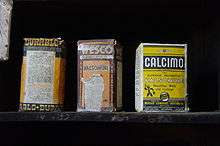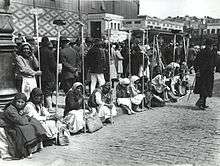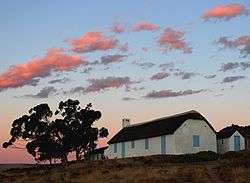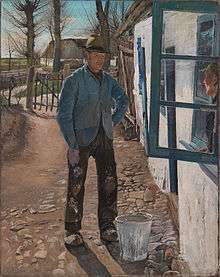Whitewash

Whitewash, or calcimine, kalsomine, calsomine, or lime paint is a type of paint made from slaked lime (calcium hydroxide, Ca(OH)2) and chalk calcium carbonate, (CaCO3), sometimes known as "whiting". Various other additives are sometimes used.
Usage as paint

Whitewash cures through a reaction with carbon dioxide in the atmosphere to form calcium carbonate in the form of calcite, a reaction known as carbonation.
It is usually applied to exteriors; however, it has been traditionally used in interiors of food preparation areas, particularly rural dairies, because of its mildly antibacterial properties. Whitewash can be tinted for decorative use and is sometimes painted inside structures such as the hallways of apartment buildings, however it can rub off onto clothing to a small degree. In Britain and Ireland, whitewash was used historically in interiors and exteriors of workers' cottages and still retains something of this association with rural poverty. In the United States, a similar attitude is expressed in the old saying: "Too proud to whitewash and too poor to paint."[1]
Whitewash is especially compatible with masonry because it is absorbed easily and the resultant chemical reaction hardens the medium.
Lime wash is pure slaked lime in water. It produces a unique surface glow due to the double refraction of calcite crystals. Limewash and whitewash both cure to become the same material.
When whitewash or limewash is initially applied, it has very low opacity, which can lead novices to overthicken the paint. Drying increases opacity and subsequent curing increases opacity even further.
Limewash relies on being drawn into a substrate unlike a modern paint that adheres to the surface. The process of being drawn in needs to be controlled by damping down. If a wall is not damped, it can leave the lime and pigments on the surface powdery; if the wall is saturated, then there is no surface tension and this can result in failure of the limewash. Damping down is not difficult but it does need to be considered before application of the limewash.[2]
Additives
Additives traditionally used include water glass, glue, egg white, Portland cement, salt, soap, milk, flour, and soil.
Whitewash is sometimes coloured with earths to achieve colours spanning the range of broken white, cream, yellow and a range of browns.
The blue laundry dye (such as Reckett's "Dolly Blue" in the UK, Ireland and Australia, Loulaki in Greece, or Mrs. Stewart's Bluing in North America) formerly widely used to give a bright tinge to boiled white textiles was a common 19th century addition and gives a pale blue paint.
Historically, pig's blood was added to give the colour Suffolk pink, a colour still widely used on house exteriors in some areas of the UK. If animal blood is applied excessively, however, its iron oxide can compromise the lime binder's strength.
Pozzolanic materials are occasionally added to give a much harder wearing paint finish. This addition, however, creates a short open time and therefore requires timely application of the altered paint.
Linseed oil is sometimes added (typically 0.5-2%) to improve adhesion on difficult surfaces.
Cement addition makes a harder wearing paint in white or grey. Open time is short, so this is added at point of use. However, the use of cement restricts the breathable aspects of the limewash and is advised to not be applied to historic buildings.
Dilute glues improve paint toughness.
Wheat flour has been used as a strength enhancing binder. Salt is often added to prevent mold . The use of salt can bring issues, such as deterioration of brick and stone.
Limitations
Basic limewash can be inadequate in its ability to prevent rain-driven water ingress. Additives are being developed but these have the potential for affecting free vapor permeability. For this reason silicate paints, more common in Germany, are gaining popularity in the UK over limewash.
Cost
Simple lime paints are very low cost. A 25-kilogram (55 lb) bag of lime makes around 100 kilograms (220 lb) of paint, and costs around £6 in the UK (2008).
Applications

Orchards
Whitewash is applied to trees, especially fruit trees, to prevent sun scald.[3] Most often only the lower trunk is painted. In Poland painting the whole trunk is also said to help keep the body of the tree cool in late winter and early spring months and hence help prevent fruit trees from blooming too soon, i.e. when warm sunny days could promote rapid tree warming, rising sap and bloom and intermittent frosty nights could damage outer tree rings and destroy the young buds and blossoms.
Dairy barns
In the middle of the 20th century, when family farms with dairy barns were common in the Upper Midwest of the United States, whitewash was a necessary part of routine barn maintenance.
A traditional animal barn contains a variety of extremely rough surfaces that are difficult to wash and keep clean, such as stone and brick masonry, and also rough-cut lumber for the ceiling. If left alone, these surfaces collect dust, dirt, insect debris and wastes, and can become very dirty.
Whitewash aids in sanitation by coating and smoothing over the rough surfaces. Successive applications of whitewash build up layers of scale that flake off and in the process remove surface debris. The coating also has antimicrobial properties that provide hygienic and sanitary benefits for animal barns.[4]
Typically the farm whitewash application is an annual process and has the following steps:
- Surfaces that are to be protected from whitewashing are enclosed in plastic sheeting or bags, such as windows, light fixtures, and the milk pipeline in a dairy barn.
- The interior is stripped of all removable equipment leaving walls, floors, and ceiling as bare as possible.
- A high volume compressed air wand is used to blast away loose whitewash scale from the walls and ceiling. This loose debris is swept into the barn gutter and goes into the manure handling system where it eventually contributes to soil fertility.
- A mobile whitewashing trailer is used to mix the quicklime into a thick liquid, which is then sprayed as an even coating over the interior walls, ceiling, and posts, into all accessible nooks and crevices.
- The coating is allowed a few hours to dry and stop dripping from the ceiling, and the protective plastic coverings are removed. Eventually after the walls and ceilings have dried sufficiently, equipment is brought back into the barn.
Other uses
Whitewash was painted on the internal walls of Royal Navy vessels during the Age of Sail to improve light levels inside a vessel's gundeck, reduce bacteria and prevent wear and tear on hull timbers.[5] It was also used during the Second World War by the German armed forces as an easy-to-apply winter camouflage for soft- and hard-skinned vehicles, aircraft and helmets.[6]
In popular culture

The incident of Tom Sawyer whitewashing a fence as punishment is a famous image in American literature. It appears in The Adventures of Tom Sawyer written in 1876 by Mark Twain.
Metaphorically, whitewashing refers to suppression or "glossing over" (possibly a close parallel construction) of potentially damaging or unwelcome information. In many British Commonwealth areas, a whitewash refers to a game in which one side fails to score at all; the usage is especially found in cricket.
See also
References
- ↑ Robinson, George W. (2015-01-13). Bert Combs The Politician: An Oral History. University Press of Kentucky. ISBN 9780813150192.
- ↑ "How to Apply Limewash - Limewashing - Buy Traditional Limewash". www.mikewye.co.uk. Archived from the original on 19 October 2016. Retrieved 3 May 2018.
- ↑ "California Agriculture PDF" (PDF). ucce.ucdavis.edu. June 1970. Archived (PDF) from the original on February 22, 2014. Retrieved February 12, 2014.
- ↑ "Fias Co Farm/Recipes- whitewash". Fiascofarm.com. Archived from the original on 2013-07-08. Retrieved 2014-02-03.
- ↑ Goodwin, Peter G. (2013). "The Application and Scheme of Paintworks in British Men-of-War in the Late Eighteenth and Early Nineteenth Centuries". The Mariner's Mirror. Portsmouth, United Kingdom: Society for Nautical Research: 288. doi:10.1080/00253359.2013.815993.
- ↑ Rothman, Gordon L.; Dennis, Peter (2013). World War II Tactical Camouflage Techniques. p. 52.
External links
| Look up whitewash in Wiktionary, the free dictionary. |
| Wikimedia Commons has media related to Whitewash. |